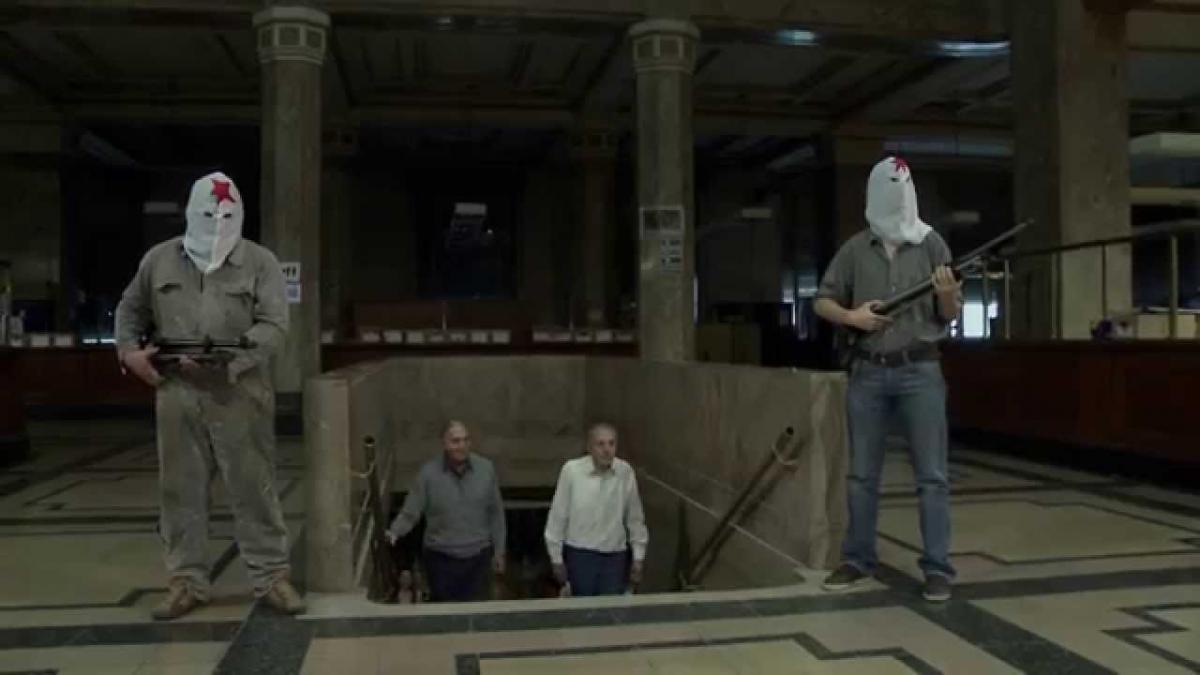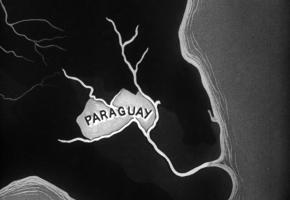This delightful documentary is about how ‘El Gordo’ Serrano and ‘El Turco’ Abus go about recreating that heist in order to make a film about it. We follow them as they audition various actors to play their younger selves and other key roles. They then return, full of emotional reminiscences, to the very bank building on Leandro Alem in Buenos Aires. It is now a vast, empty and abandoned building after being closed by Carlos Menem in 1993. It is, apparently, used to store large quantities of (equally abandoned) box files. Re-visiting the scene-of-the-crime for the first time in over 40 years, the elderly Serrano and Abus re-live and recreate those times and the raid, spending hours trying to convey to the young actors, the mood, thoughts and emotions that they had then and why they felt the need to do their bit for the cause.
The whole robbery might have been politically motivated and carried out by an armed guerrilla group, but this recreation has resulted in a gentle, funny and warm study of generational differences. We see young people, born after 1983, who never lived through either of the two dictatorships, who never experienced the fear and the abuses. We see them question and struggle to inhabit their characters, more so having the originals right beside them. Both sides make an effort to cross this divide, as the young actors try to understand what it was like to be a bank worker or an armed militant in 1971.

Oscar 'El Gordo' Serrano and Ángel 'El Turco' Abus
Oscar Serrano and Ángel Abus were fast friends when they worked at BANADE, (the Banco Nacional de Desarrollo in Buenos Aires). The bank, situated a stone’s throw from La Casa Rosada (Government House) was called the ‘Banco de Crédito Industrial de la República Argentina’ when it was founded in 1944 by General Juan D. Perón, to promote the post- war national industries in Argentina.

Re-construction of the day of the raid.
Oscar ‘el Gordo’ Serrano worked as a security guard, and ran a taxi (a wonderful Siam Di Tella 1500) with a friend in his spare time, while ‘El Turco’ Abus operated the lifts. No one could have imagined that these two inconspicuous employees would ever be able to access sensitive information or work out how to break into the vaults. But they had sussed, from colleagues, that not all the funds reached the projects they were designed for. The books were being cooked and huge sums of money were vanishing from the bank; corruption and nepotism was rife. This got deep under their skin. 'El Gordo' was very clear about his opinion of the situation: - “Those w******s were sharing the money among themselves, money that they were stealing from the workers.”

The façade of the BANADE with the classic Siam Di Tella 1500 taxi- Oscar's pride and joy.
The Military Regime wanted to deliver the “Argentine Revolution” (the name given to the military coup d’état that overthrew the government of Arturo Umberto Illia in 1966). From the start, with General Juan Carlos Onganía, the regime had tried to establish a new political and social order strongly opposing liberal democracy and Communism. They ended University autonomy and started eradicating shanty towns. It was labelled an ‘authoritarian-bureaucratic state’ by Guillermo O’Donnel, the political scientist. This takeover echoed the military coup d’état that had taken place in Brazil in 1964 just two years earlier.

El Cordobazo- massive demostration, Córboba, Argentina May 1969.
The new military regime failed to address the high level of social inequality and these further measures simply fed the flames, leading to greater political unrest. Many resistance groups began to take shape, some evolving from the original ‘Peronist Youth’ groups. The movements by these growing left-wing movements resulted in violent protests and general strikes, such as ‘el Cordobazo’ (1969) where huge demonstrations of students and workers rebelled against the government of General Onganía. The militant groups then became more confident and armed actions began to take place, largely against Police, Army or other significant targets. In 1969, the People’s Revolutionary Army (ERP) was created, becoming the militant arm of the ‘Worker’s Revolutionary Party’ (PRT) a communist party that emerged from the Trotskyist tradition, eventually turning to the Maoist theories of the Cultural Revolution. By 1971, further militant groups had become active, including the Catholic nationalist & Peronist Montoneros and the FAR, the Fuerzas Armadas Revolucionarias (Revolutionary Armed Forces). Despite General Lanusse trying to defuse the situation in 1971, by initiating large infrastructure projects, roads and bridges etc, he seemed unable to solve the needs and demands for proper social and economic policies to improve the lives of the ordinary people.

Main foyer of the BANADE in 2013.
Oscar, ‘el Gordo’ and Ángel ‘el Turco’, being merely two bank employees, had never had any contact with violence, but they felt compelled to play their part in the resistance to what they saw as abuses by the regime. Initially, they took their idea to the FAR (Revolutionary Armed Forces), but they rejected it for being too close to government house, making it a risky and near impossible task. Not planning to give up, the two then contacted the ERP (People’s Revolutionary Party) and convinced them that the ERP could remove huge sums of money without being detected. They wanted to hit the government where it hurt. They were met with lots of scepticism, but gradually, their idea caught hold.

Pablo Trimarchi and Oscar Serrano whom he plays in the film
In an emotional encounter for the two bank workers, they met Victor F. Palmeiro ‘el Gallego’, who represented the ERP-PRT, in a warehouse. It was there that the all-important oxyacetylene blowtorch (that was to play a key role in the robbery) was found. According to Raúl Argemí, novelist and activist, who was at that reunion, he told them that the blowtorch can reach temperatures of 3,000 degrees and can cut steel ‘… like butter’.

El Tordo, Osvaldo Di Benedetti leader of the militant ERP group that raided the bank
They soon found out this was a huge exaggeration, as it ended up requiring at least 4 blow-torchers when the planned 20-minutes allowed on the day, inevitably expanded to 5 hours and they almost choked on the toxic fumes.

Plan that was drawn up from the blueprints
So it was that ‘El Gordo’ and ‘El Turco’ told ‘El Gallego’ that, having worked there for a long time, they knew exact details of the construction of the bank. They were aware of the existence of ‘a large hole’ into the safety-deposit vault, that had been cut for an air- conditioning unit, due to complaints from the staff about it being too hot to work inside. This opening revealed the safety structures built inside the wall in great detail.

Federico Pereyra and Ángel Abus
Raymundo Gleyzer, a film maker and technician, who was also an active member of the ERP, played the part of ‘Q’ and gave them a tiny Minox spy camera to make up a dossier of all the areas they needed to reconnoitre. The photographs that the two provided, then persuaded the activist group’s architect (José Miguel País) to confirm he thought the plan was viable. The two bank workers insisted, as a precondition, that none of the bank staff would be hurt, especially one who was known to have a heart condition. To gather them altogether in one place safely, Abus pretended he had won some money at the pools and invited them all to a dinner in the entrance hall. So, when the armed and masked guerrillas arrived, they were totally surprised. One of the militants, being a doctor, made sure the more vulnerable staff were safe before being locked in a room.

Federico Pereyra who plays Ángel 'El Turco' Abus examines newspaper cuttings of the time.
So, without a shot being fired, a group from ERP managed to cart away 10 million dollars (450 million pesos) to be ‘re-distributed’. The group had been led by Osvaldo ‘El Tordo’ De Benedetti, and Jorge Belomo, (the doctor) who was his second in command. Nevertheless, the most important member was the activist José Miguel País, who being an architect, worked out every stage of the process on the day.

Rocío Domínguez and Laura ' Beba' Zona whom she plays in the film.
The film rambles but is never dull, and the charm of the two protagonists is very affective. They were forced to flee the country as a result of the heist and only now got together again, after all these years, to participate in this documentary. Sadly, Abus was already suffering from advanced cancer and died shortly after the film was finished. Oscar Serrano has now returned to Cuba where he is a professor of Art.

Raymundo Gleyzer in 1972
Some members of the armed group had a sad ending. The architect Pais was kidnapped in 1976, ‘El Tordo’ De Benedetti was assassinated with a shot to the head in 1978 in Tucumán (North Eastern Argentina) Raymundo Gleyzer went ‘missing’ in 1976, as did the doctor, Belomo, who was arrested and also became another statistic on the list of the ‘disappeared’.
-El que va a la guerra es uno. El que vuelve es otro- (One man goes to war, another returns)
SERÉ MILLONES (2013)
https://vimeo.com/199414689?fbclid=IwAR0iXXU50W8uvPnI5d8_i3wjH0JFdpWMHh…
https://vimeo.com/ondemand/seremillones
Interview with the creators:
Entrevista con los realizadores
https://vimeo.com/459795283/fef2a91758
Written, Directed & Edited by Omar Neri, Fernando Krichmar and Mónica Simoncini
Producer Alejandra Guzzo
DOP Alexis Roitman and Dionisio Cardoso
Direct and Post sync sound Rubén Piputto & Horacio Almad
Music Jorge Senno
Research Valeria Zeferino Acuña Y Romina Migueles.
Cast:
Oscar ‘El Gordo’ Serrano, Laura ‘Beba’ Zona & Ángel ‘El Turco’ Abus as themselves.
Federico Pereyra as Ángel ‘El Turco’ Abus
Pablo Trimarchi as Oscar ‘El Gordo’ Serrano
Rocío Domínguez as Laura ‘Beba’ Zona
Enzo Ordeig as ‘El Gallego’ Víctor F Palmeiro aka Dedo (Finger)
Gonzalo Alfonsín as Raymundo Gleyzer
Walter Pérez Hernández as Mario Roberto ‘Robi’ Santucho
Production Company www.mascarocine.org Mascaró

















